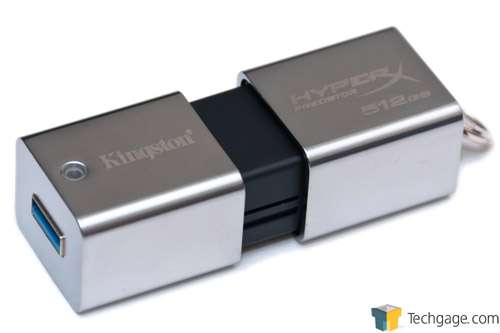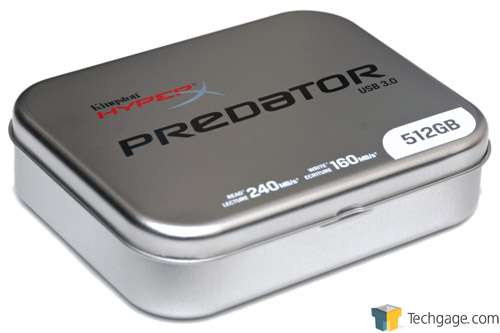- Qualcomm Launches Snapdragon 4 Gen 2 Mobile Platform
- AMD Launches Ryzen PRO 7000 Series Mobile & Desktop Platform
- Intel Launches Sleek Single-Slot Arc Pro A60 Workstation Graphics Card
- NVIDIA Announces Latest Ada Lovelace Additions: GeForce RTX 4060 Ti & RTX 4060
- Maxon Redshift With AMD Radeon GPU Rendering Support Now Available
Kingston DT HyperX Predator 512GB Flash Drive Review

For years, there’s been a constant battle in the flash drive market where companies have tried to build the smallest drive possible but boast the most amount of space. In this regard, it has to be said that Kingston is the current winner. Its DT HyperX Predator isn’t much larger than a regular performance thumb drive, but its storage starts out at 512GB.
Page 4 – Final Thoughts
Kingston’s Predator is an interesting flash drive for the simplest of reasons. It might not be feature-packed, and it might not be innovative, but what it is, is a well-built product that offers fast speeds and a ton of storage space. In the car world, Predator would be like a Porsche with the towing capacity of a full-sized truck.
Sure, the Predator is expensive, but that’s a given. As mentioned earlier, NAND chips that offer this much storage don’t come cheap, and in some ways, it’s impressive at all that Kingston was able to pull this off with such a small drive and still be able to offer it at a price that scales reasonably well.
Take Kingston’s own HyperX 64GB, for example, which retails for $90 at the moment. Multiplied 8x to match 512GB, it’d become a $720 drive. The Predator, by contrast, retails for $80 beyond that, but employs the sturdiest design both inside and out that we’ve ever seen. There’s a premium, but it’s justified.
That being said, there are a couple of problems I do have with the drive. The first is the odd partitioning that the drive ships with. I can understand using FAT32 for the sake of compatibility, but let’s be realistic – who is going to own this drive and not store 4GB+ files on it? Kingston should have instead formatted it using NTFS, a file system that rids that limitation and can be used cross-platform.
The second oddity has to do with the fact that Kingston partitioned the drive using 32KB clusters. Again, if all you’re copying over are large files, this is normally fine, but that’s not usually the case for a lot of people. Instead, we use these as backup drives, which means many smaller files will be copied on over in addition to larger ones. As we saw on the previous page, all of our real-world transfers – both solid file and folder – sped up tremendously when formatted to use 4KB clusters vs. the default 32KB. We’re talking 22 seconds for a 4GB file vs. 28 seconds and 172 seconds for the 4GB folder vs. 238 seconds. By choosing 32KB clusters, Kingston in our minds actually slows down the drive for what we feel most people will use it for.
To be fair to Kingston, it could be assumed that if someone were to purchase an $800 flash drive, they’d understand partitions well enough to format it to their liking. But the truth is, a lot of people don’t realize either the performance or space detriments that can be introduced when using certain cluster sizes.
For example, on a hard drive partitioned using 32KB clusters, each write of data to the disk is exactly 32KB. If a file is 1KB, it takes up 32KB on the disk. If a file is 50KB, it takes up 64KB. This means that if a big cluster size is used when mostly small files are being stored, a lot of space stands to be wasted. This can even be true on 4KB-formatted drives if hundreds of thousands of files are being stored, but the problem can of course be worse with far fewer files but larger clusters.
One area where Kingston’s flash drives have left a bit to be desired in the past is in the IOPS department, and the Predator doesn’t change things. IOPS stands for input/output-operations-per-second and describes the number of transfers that a storage device can handle at once. The higher the IOPS, the better.
I am not going to focus on this too much as for the most part, it’s not that important – plus, I am not familiar with current competitor offerings. But in our real-world transfer tests, WD’s My Passport 2TB 2.5-inch hard drive out-performed Kingston’s Predator – something we wouldn’t expect given the drive’s design and specs. But the results were staggering – WD’s mechanical drive was twice as fast. Things change when single, large files are concerned, but that’s the point where IOPS don’t matter; throughput does.
The take-away? The Predator is amazing for large files, but not so amazing for a ton of little files.
This does make me wonder if Kingston would be able to implement a small SSD-level NAND chip to act as cache in the drive, at about 4GB. We’ve seen this design implemented in hard drives in the past, and it does help.
So let’s create a tl;dr for the past 700 words, shall we?
Kingston’s DataTraveler HyperX Predator drive is expensive, but isn’t priced outside the realm of reason given its performance and price-scaling. It offers superb solid-file performance but falls a bit flat when a lot of smaller files are concerned. It’s the best-built thumb drive we’ve ever laid our hands on – and we mean that. If not for that fact that the drive costs $800, I would have been tempted to run it over with a truck.
The Predator isn’t for everyone. It’s targeted squarely at those who need mass storage in the smallest device possible. For the rest of us, the $150 WD My Passport 2TB 2.5-inch is going to be a far easier option to stomach.
Support our efforts! With ad revenue at an all-time low for written websites, we're relying more than ever on reader support to help us continue putting so much effort into this type of content. You can support us by becoming a Patron, or by using our Amazon shopping affiliate links listed through our articles. Thanks for your support!







